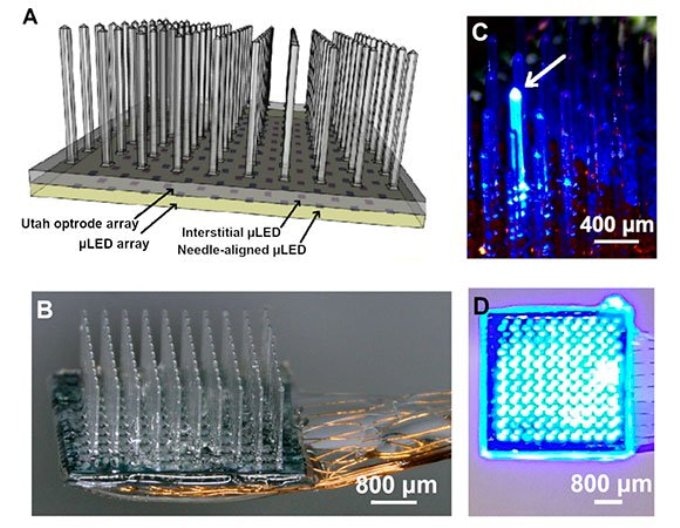Aug 30 2019
Scientists have developed an implantable optrode array that can stimulate below-surface neurons in the brains of large mammals at two levels—through large-volume illumination and structured-light delivery.
 (Image credit: SPIE)
(Image credit: SPIE)
The article titled “A multi-site microLED optrode array for neural interfacing” has been reported in the peer-reviewed, open-access SPIE publication, Neurophotonics. This advancement holds implications for studies attempting to connect neural activity to particular cognitive functions in huge mammals.
Although other optogenetic devices have been developed before, this recent breakthrough deals with a range of ongoing improvements and challenges when it comes to neuroscience and optical stimulation in massive animal models.
Improved elements include heat control, depth of access, and an electric delivery system that can be used with upcoming wireless applications. To achieve this, a glass needle array is connected to a customized microLED array, and a lightweight and compact device optimally suitable for behavioral studies is created.
According to Neurophotonics Associate Editor Anna Wang Roe, a professor in the Division of Neuroscience at the Oregon National Primate Research Center and director of the Interdisciplinary Institute of Neuroscience and Technology at Zhejiang University in Hangzhou, China, the novel technology brings exciting prospects to new mammalian behavioral findings.
The development of a large array multisite optical stimulator is a significant advance in the field of optogenetics and optical stimulation. Having this array will lead to the ability to stimulate multiple cortical sites simultaneously or sequentially, in a cell-type specific manner.
Anna Wang Roe, Professor, Division of Neuroscience, Oregon National Primate Research Center
Roe continued, “It may also open up the possibility of stimulating with different wavelengths, and therefore different cell types, at selected locations. This capability broadens the menu of possible stimulation paradigms for brain-machine interface.”
Authors who contributed to the article are Niall McAlinden, Yunzhou Cheng, Enyuan Xie, Erdan Gu, Martin D. Dawson, and Keith Mathieson of the University of Strathclyde’s Institute of Photonics, Glasgow, Scotland; Robert Scharf, Christopher F. Reiche, Steve Blair, Prashant Tathireddy, and Rohit Sharma of the University of Utah’s Department of Electrical and Computer Engineering, Salt Lake City, United States.
In addition, Loren Rieth from the Fienstein Institute for Medical Research, Manhasset, New York, United States also contributed to the article.
The study was funded by the NIH via the US BRAIN Initiative.